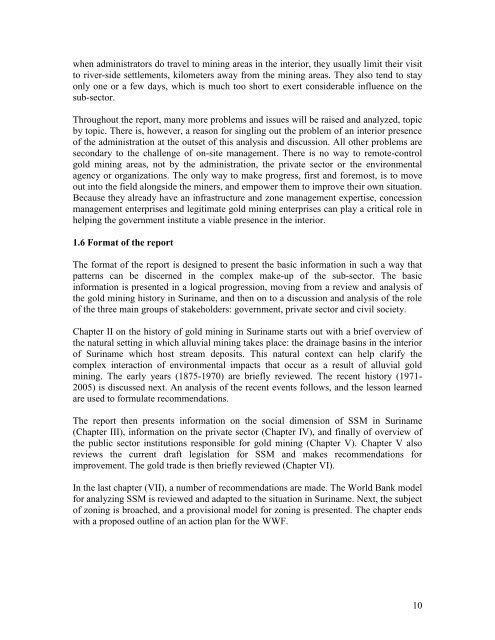SITUATION ANALYSIS OF THE SMALL-SCALE GOLD ... - WWF
SITUATION ANALYSIS OF THE SMALL-SCALE GOLD ... - WWF
SITUATION ANALYSIS OF THE SMALL-SCALE GOLD ... - WWF
You also want an ePaper? Increase the reach of your titles
YUMPU automatically turns print PDFs into web optimized ePapers that Google loves.
when administrators do travel to mining areas in the interior, they usually limit their visit<br />
to river-side settlements, kilometers away from the mining areas. They also tend to stay<br />
only one or a few days, which is much too short to exert considerable influence on the<br />
sub-sector.<br />
Throughout the report, many more problems and issues will be raised and analyzed, topic<br />
by topic. There is, however, a reason for singling out the problem of an interior presence<br />
of the administration at the outset of this analysis and discussion. All other problems are<br />
secondary to the challenge of on-site management. There is no way to remote-control<br />
gold mining areas, not by the administration, the private sector or the environmental<br />
agency or organizations. The only way to make progress, first and foremost, is to move<br />
out into the field alongside the miners, and empower them to improve their own situation.<br />
Because they already have an infrastructure and zone management expertise, concession<br />
management enterprises and legitimate gold mining enterprises can play a critical role in<br />
helping the government institute a viable presence in the interior.<br />
1.6 Format of the report<br />
The format of the report is designed to present the basic information in such a way that<br />
patterns can be discerned in the complex make-up of the sub-sector. The basic<br />
information is presented in a logical progression, moving from a review and analysis of<br />
the gold mining history in Suriname, and then on to a discussion and analysis of the role<br />
of the three main groups of stakeholders: government, private sector and civil society.<br />
Chapter II on the history of gold mining in Suriname starts out with a brief overview of<br />
the natural setting in which alluvial mining takes place: the drainage basins in the interior<br />
of Suriname which host stream deposits. This natural context can help clarify the<br />
complex interaction of environmental impacts that occur as a result of alluvial gold<br />
mining. The early years (1875-1970) are briefly reviewed. The recent history (1971-<br />
2005) is discussed next. An analysis of the recent events follows, and the lesson learned<br />
are used to formulate recommendations.<br />
The report then presents information on the social dimension of SSM in Suriname<br />
(Chapter III), information on the private sector (Chapter IV), and finally of overview of<br />
the public sector institutions responsible for gold mining (Chapter V). Chapter V also<br />
reviews the current draft legislation for SSM and makes recommendations for<br />
improvement. The gold trade is then briefly reviewed (Chapter VI).<br />
In the last chapter (VII), a number of recommendations are made. The World Bank model<br />
for analyzing SSM is reviewed and adapted to the situation in Suriname. Next, the subject<br />
of zoning is broached, and a provisional model for zoning is presented. The chapter ends<br />
with a proposed outline of an action plan for the <strong>WWF</strong>.<br />
10
















